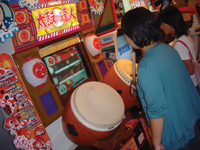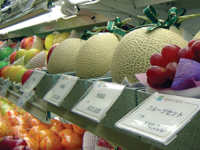The Pulse 1
Back to Contents of Issue: November 2003
|
|
|
|
by The Editors |
|
|
The Arcades are Alright
What impressed us most was the sheer inventiveness of the games. Arcades have been around for nearly 30 years, and there has always been a fear that once every genre had been tried there would be no more bottomless pit for kids' pocket money. What the mainly Japanese makers displaying their wares clearly showed was that even the oldest genres can still be rendered fresh and exciting.
Sega provided a prime example of this: It has now designed a hydraulic simulator into which any piece of driving or flying software can be loaded. To demonstrate the versatility of this fearsome device, each of us chose a different vehicle.
One was in a Karting championship, the other in a futuristic cyber-sled. As we each incompetently lurched around a road and a space arena, respectively, the machine hurled us about in perfect synchronization with the events on the screen. Dizzily and dazedly staggering off, we concluded that the effects were far too close to reality for comfort -- at least for anyone over 15.
Music was a big theme of the whole show. Many games concentrate on plastic versions of classical instruments and encourage even the most tone-deaf to play along with famous old tunes.
One of us plucked at a Shamisen, the other pounded on a Kodo drum until he was red in the face. Later, we both squeezed into a tiny booth for a karaoke showdown. As we warbled our way through a couple of Morning Musume belters, we were rewarded with little sweets -- depending on which of us hit the truer notes.
Elsewhere, the theme of physical reward was also a strong one -- and this, we believe, is what the message of the show was. The innovation that has been poured into Japanese arcade games over the years means that the technology has far outstripped the raw concepts.
Finally, the likes of Namco, Sammy, Taito and Sega have realized what they need to do: keep the gaming simple, but reward people for their success. Like it or not, arcade culture is not what it was in the 80s, and customers need more than a high score to walk away from a machine satisfied. Now they want fluffy toys as well.
The games makers have responded by adding a prize contingent to almost every type of game -- driving simulators that pump out prize tokens, sophisticated prize-grabber games, Print Club machines that connect to mobile phones and a host of others. We rounded a corner to see our hunch proven exactly correct: This show was meant for arcade owners, and yet an area the size of a football field was devoted to merchandise. Just row after row of fluffy physical rewards to take home and treasure.
-- The Editors
Japan's Fruit Filchers
A recently released National Police Agency report reveals that thefts of farm produce and marine products across Japan skyrocketed 48.1 percent over the previous year. Damage totals have reached an estimated JPY55.9 million, an increase of 81.8 percent.
What's worse -- police authorities have managed to break only 13 of the 480 cases reported thus far.
With a perfect honeydew melon commanding as much as JPY75,000 for a corporate gift, and the finest grapes selling for up to JPY14,000 a bunch, thieves are scouring the countryside for the finest fruit.
Exorbitant prices for domestically grown fruit and vegetables have long been the norm in Japan, where the local goods are considered far superior to much cheaper imports from elsewhere in Asia. Many Japanese place a particular premium on produce that is free of blemishes or has patterned skin.
But even those outrageous base prices have shot up in recent weeks, following an unusually poor harvest. Japan had a cool, wet summer, cutting both the crop yield and its quality.
Several gangs of fruit thieves are believed to be responsible -- but there has yet to be an arrest.
What the thieves have in common is an eye for perfect fruit, even in the dark. They are also thought to have developed an efficient distribution network since their ill-gotten gains perish very quickly. With a poor harvest, selling the fruit is easy. "These days we take whatever we can," explains Chie Harada, owner of Harada Fruits in Shinagawa, Tokyo. "I'm not too worried about who the supplier is anymore."
"We would have seen them if they used any lamps or flashlights in the orchard," says one farmer from Yokohama, bemoaning the theft of about 150 kg of ripe pears worth about JPY185,000. "You really have to know what you are doing to be able to select the right pear in the moonlight. Only a professional fruit grower would be able to spot the ideal darkness and tenderness of the skin."
Tendo, a small northern town famous for its cherries, has been particularly hard hit by the crime spree. In a ten-day rampage -- judged by a spokesperson for the local agricultural cooperative to have been the worst in living memory -- more than 1.2 tons of prime black satonishiki cherries were plucked from the trees. In the department stores of Tokyo's Ginza district, the theft could be worth an estimated JPY11 million.
There was more evidence that the criminals were horticulturalists: the pickers left the developing buds untouched.
Police have at least one clue: In a single night's work, 500 kg of cherries were stolen, which means at least ten thieves worked together. Experts from the Higashine agricultural co-operative have assured investigators that even the most experienced cherry-picker can grab only 50 kg a day.
Farmers from Hokkaido to Okinawa continue to lose their precious wares and face financial ruin. In a theft worth about JPY558,000, some 600 pears were stolen from a farm in Kamagaya. Days later, 500 even pricier pears disappeared from the same farm.
The biggest pear haul to date was in the famous growing region of Shimotsuma, costing the unfortunate farmer nearly JPY3 million.
-- The Editors
|
|
Note: The function "email this page" is currently not supported for this page.


 JAPAN'S ARCADE INDUSTRY MAY be flagging a little, but you certainly wouldn't guess it from the Tokyo Amusement Machines Show. We went down to the massive trade fair in September and spent the day playing the latest arcade games and browsing the state-of-the-art technology. When our arms and feet were exhausted from prodding buttons and stomping pedals, we were left with a strong impression: If this is one of the industries that has allegedly started running out of steam, then Japan doesn't have much to worry about.
JAPAN'S ARCADE INDUSTRY MAY be flagging a little, but you certainly wouldn't guess it from the Tokyo Amusement Machines Show. We went down to the massive trade fair in September and spent the day playing the latest arcade games and browsing the state-of-the-art technology. When our arms and feet were exhausted from prodding buttons and stomping pedals, we were left with a strong impression: If this is one of the industries that has allegedly started running out of steam, then Japan doesn't have much to worry about.
 ACROSS THE COUNTRY, JAPAN'S farmers are suddenly suffering a spate of nocturnal fruit thefts prompted by astronomical market prices.
ACROSS THE COUNTRY, JAPAN'S farmers are suddenly suffering a spate of nocturnal fruit thefts prompted by astronomical market prices.




